Kelsey R. Allen
Neural Assets: 3D-Aware Multi-Object Scene Synthesis with Image Diffusion Models
Jun 13, 2024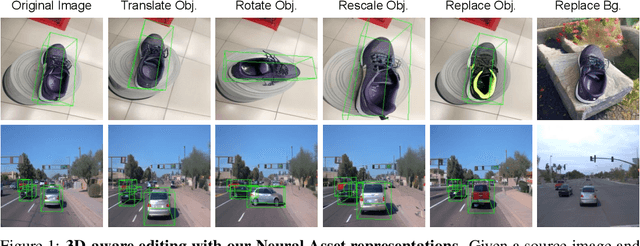
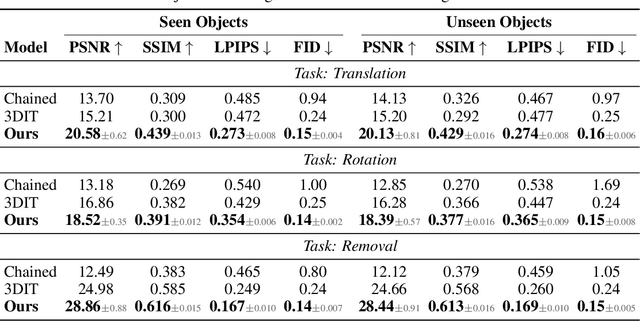

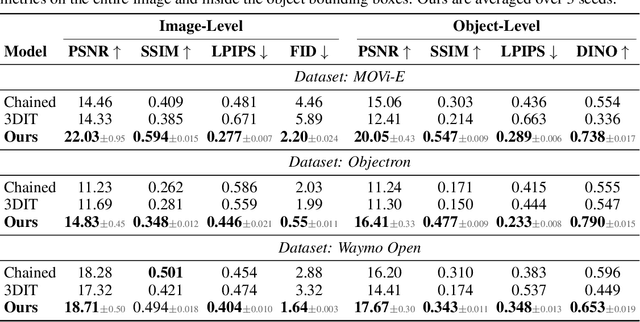
Abstract:We address the problem of multi-object 3D pose control in image diffusion models. Instead of conditioning on a sequence of text tokens, we propose to use a set of per-object representations, Neural Assets, to control the 3D pose of individual objects in a scene. Neural Assets are obtained by pooling visual representations of objects from a reference image, such as a frame in a video, and are trained to reconstruct the respective objects in a different image, e.g., a later frame in the video. Importantly, we encode object visuals from the reference image while conditioning on object poses from the target frame. This enables learning disentangled appearance and pose features. Combining visual and 3D pose representations in a sequence-of-tokens format allows us to keep the text-to-image architecture of existing models, with Neural Assets in place of text tokens. By fine-tuning a pre-trained text-to-image diffusion model with this information, our approach enables fine-grained 3D pose and placement control of individual objects in a scene. We further demonstrate that Neural Assets can be transferred and recomposed across different scenes. Our model achieves state-of-the-art multi-object editing results on both synthetic 3D scene datasets, as well as two real-world video datasets (Objectron, Waymo Open).
Learning rigid-body simulators over implicit shapes for large-scale scenes and vision
May 22, 2024Abstract:Simulating large scenes with many rigid objects is crucial for a variety of applications, such as robotics, engineering, film and video games. Rigid interactions are notoriously hard to model: small changes to the initial state or the simulation parameters can lead to large changes in the final state. Recently, learned simulators based on graph networks (GNNs) were developed as an alternative to hand-designed simulators like MuJoCo and PyBullet. They are able to accurately capture dynamics of real objects directly from real-world observations. However, current state-of-the-art learned simulators operate on meshes and scale poorly to scenes with many objects or detailed shapes. Here we present SDF-Sim, the first learned rigid-body simulator designed for scale. We use learned signed-distance functions (SDFs) to represent the object shapes and to speed up distance computation. We design the simulator to leverage SDFs and avoid the fundamental bottleneck of the previous simulators associated with collision detection. For the first time in literature, we demonstrate that we can scale the GNN-based simulators to scenes with hundreds of objects and up to 1.1 million nodes, where mesh-based approaches run out of memory. Finally, we show that SDF-Sim can be applied to real world scenes by extracting SDFs from multi-view images.
Scaling Face Interaction Graph Networks to Real World Scenes
Jan 22, 2024Abstract:Accurately simulating real world object dynamics is essential for various applications such as robotics, engineering, graphics, and design. To better capture complex real dynamics such as contact and friction, learned simulators based on graph networks have recently shown great promise. However, applying these learned simulators to real scenes comes with two major challenges: first, scaling learned simulators to handle the complexity of real world scenes which can involve hundreds of objects each with complicated 3D shapes, and second, handling inputs from perception rather than 3D state information. Here we introduce a method which substantially reduces the memory required to run graph-based learned simulators. Based on this memory-efficient simulation model, we then present a perceptual interface in the form of editable NeRFs which can convert real-world scenes into a structured representation that can be processed by graph network simulator. We show that our method uses substantially less memory than previous graph-based simulators while retaining their accuracy, and that the simulators learned in synthetic environments can be applied to real world scenes captured from multiple camera angles. This paves the way for expanding the application of learned simulators to settings where only perceptual information is available at inference time.
Learning 3D Particle-based Simulators from RGB-D Videos
Dec 08, 2023



Abstract:Realistic simulation is critical for applications ranging from robotics to animation. Traditional analytic simulators sometimes struggle to capture sufficiently realistic simulation which can lead to problems including the well known "sim-to-real" gap in robotics. Learned simulators have emerged as an alternative for better capturing real-world physical dynamics, but require access to privileged ground truth physics information such as precise object geometry or particle tracks. Here we propose a method for learning simulators directly from observations. Visual Particle Dynamics (VPD) jointly learns a latent particle-based representation of 3D scenes, a neural simulator of the latent particle dynamics, and a renderer that can produce images of the scene from arbitrary views. VPD learns end to end from posed RGB-D videos and does not require access to privileged information. Unlike existing 2D video prediction models, we show that VPD's 3D structure enables scene editing and long-term predictions. These results pave the way for downstream applications ranging from video editing to robotic planning.
Learning rigid dynamics with face interaction graph networks
Dec 07, 2022



Abstract:Simulating rigid collisions among arbitrary shapes is notoriously difficult due to complex geometry and the strong non-linearity of the interactions. While graph neural network (GNN)-based models are effective at learning to simulate complex physical dynamics, such as fluids, cloth and articulated bodies, they have been less effective and efficient on rigid-body physics, except with very simple shapes. Existing methods that model collisions through the meshes' nodes are often inaccurate because they struggle when collisions occur on faces far from nodes. Alternative approaches that represent the geometry densely with many particles are prohibitively expensive for complex shapes. Here we introduce the Face Interaction Graph Network (FIGNet) which extends beyond GNN-based methods, and computes interactions between mesh faces, rather than nodes. Compared to learned node- and particle-based methods, FIGNet is around 4x more accurate in simulating complex shape interactions, while also 8x more computationally efficient on sparse, rigid meshes. Moreover, FIGNet can learn frictional dynamics directly from real-world data, and can be more accurate than analytical solvers given modest amounts of training data. FIGNet represents a key step forward in one of the few remaining physical domains which have seen little competition from learned simulators, and offers allied fields such as robotics, graphics and mechanical design a new tool for simulation and model-based planning.
Physical Design using Differentiable Learned Simulators
Feb 01, 2022Abstract:Designing physical artifacts that serve a purpose - such as tools and other functional structures - is central to engineering as well as everyday human behavior. Though automating design has tremendous promise, general-purpose methods do not yet exist. Here we explore a simple, fast, and robust approach to inverse design which combines learned forward simulators based on graph neural networks with gradient-based design optimization. Our approach solves high-dimensional problems with complex physical dynamics, including designing surfaces and tools to manipulate fluid flows and optimizing the shape of an airfoil to minimize drag. This framework produces high-quality designs by propagating gradients through trajectories of hundreds of steps, even when using models that were pre-trained for single-step predictions on data substantially different from the design tasks. In our fluid manipulation tasks, the resulting designs outperformed those found by sampling-based optimization techniques. In airfoil design, they matched the quality of those obtained with a specialized solver. Our results suggest that despite some remaining challenges, machine learning-based simulators are maturing to the point where they can support general-purpose design optimization across a variety of domains.
The Tools Challenge: Rapid Trial-and-Error Learning in Physical Problem Solving
Jul 25, 2019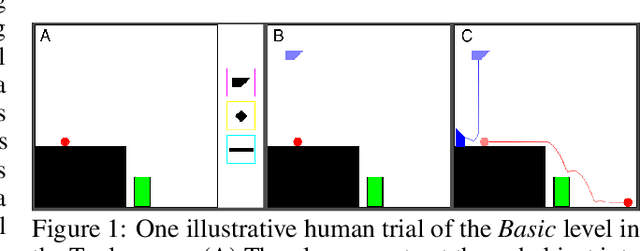

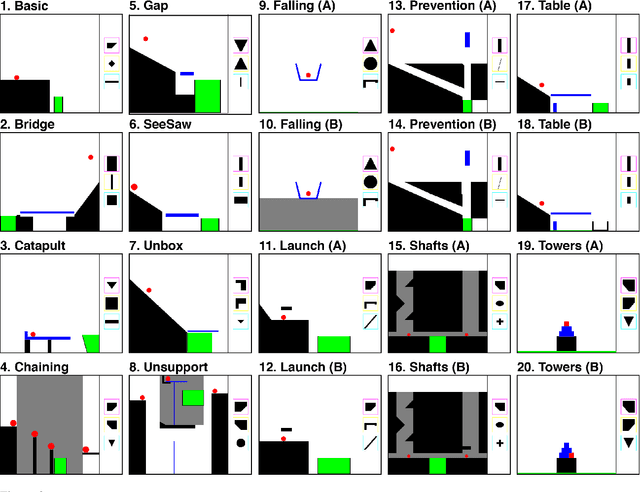
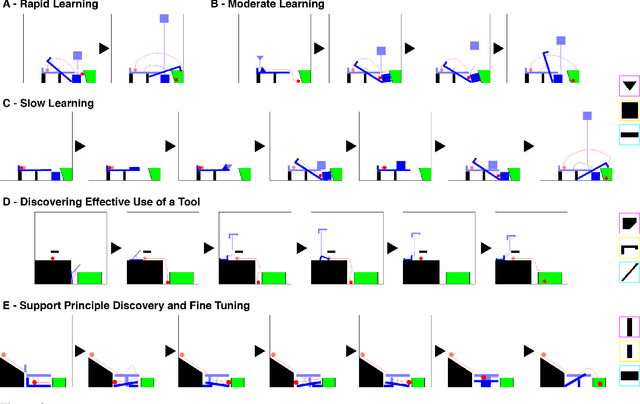
Abstract:Many animals, and an increasing number of artificial agents, display sophisticated capabilities to perceive and manipulate objects. But human beings remain distinctive in their capacity for flexible, creative tool use -- using objects in new ways to act on the world, achieve a goal, or solve a problem. Here we introduce the "Tools" game, a simple but challenging domain for studying this behavior in human and artificial agents. Players place objects in a dynamic scene to accomplish a goal that can only be achieved if those objects interact with other scene elements in appropriate ways: for instance, launching, blocking, supporting or tipping them. Only a few attempts are permitted, requiring rapid trial-and-error learning if a solution is not found at first. We propose a "Sample, Simulate, Update" (SSUP) framework for modeling how people solve these challenges, based on exploiting rich world knowledge to sample actions that would lead to successful outcomes, simulate candidate actions before trying them out, and update beliefs about which tools and actions are best in a rapid learning loop. SSUP captures human performance well across 20 levels of the Tools game, and fits significantly better than alternate accounts based on deep reinforcement learning or learning the simulator parameters online. We discuss how the Tools challenge might guide the development of better physical reasoning agents in AI, as well as better accounts of human physical reasoning and tool use.
Few-Shot Bayesian Imitation Learning with Logic over Programs
Apr 12, 2019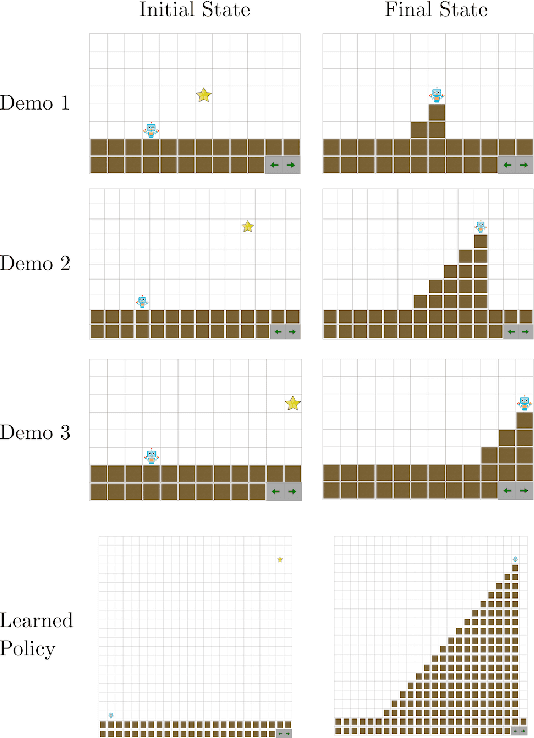


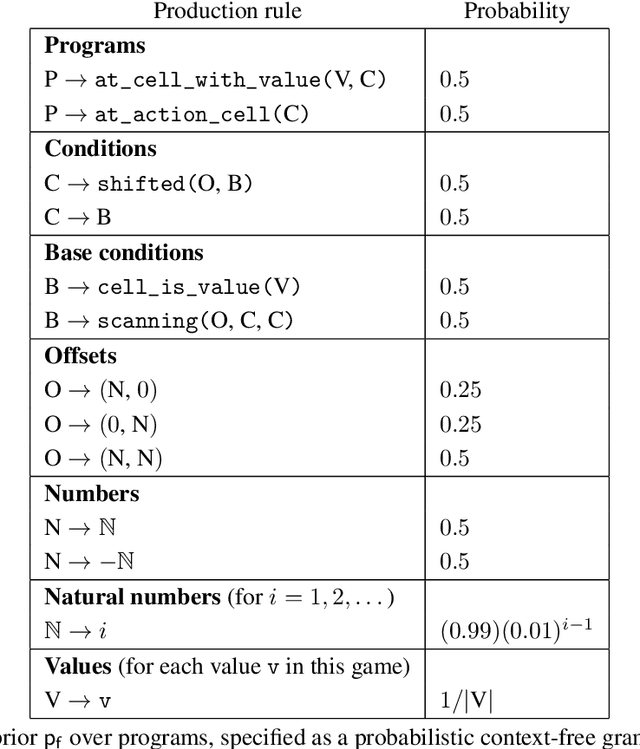
Abstract:We describe an expressive class of policies that can be efficiently learned from a few demonstrations. Policies are represented as logical combinations of programs drawn from a small domain-specific language (DSL). We define a prior over policies with a probabilistic grammar and derive an approximate Bayesian inference algorithm to learn policies from demonstrations. In experiments, we study five strategy games played on a 2D grid with one shared DSL. After a few demonstrations of each game, the inferred policies generalize to new game instances that differ substantially from the demonstrations. We argue that the proposed method is an apt choice for policy learning tasks that have scarce training data and feature significant, structured variation between task instances.
Infinite Mixture Prototypes for Few-Shot Learning
Feb 12, 2019



Abstract:We propose infinite mixture prototypes to adaptively represent both simple and complex data distributions for few-shot learning. Our infinite mixture prototypes represent each class by a set of clusters, unlike existing prototypical methods that represent each class by a single cluster. By inferring the number of clusters, infinite mixture prototypes interpolate between nearest neighbor and prototypical representations, which improves accuracy and robustness in the few-shot regime. We show the importance of adaptive capacity for capturing complex data distributions such as alphabets, with 25% absolute accuracy improvements over prototypical networks, while still maintaining or improving accuracy on the standard Omniglot and mini-ImageNet benchmarks. In clustering labeled and unlabeled data by the same clustering rule, infinite mixture prototypes achieves state-of-the-art semi-supervised accuracy. As a further capability, we show that infinite mixture prototypes can perform purely unsupervised clustering, unlike existing prototypical methods.
Relational inductive bias for physical construction in humans and machines
Jun 04, 2018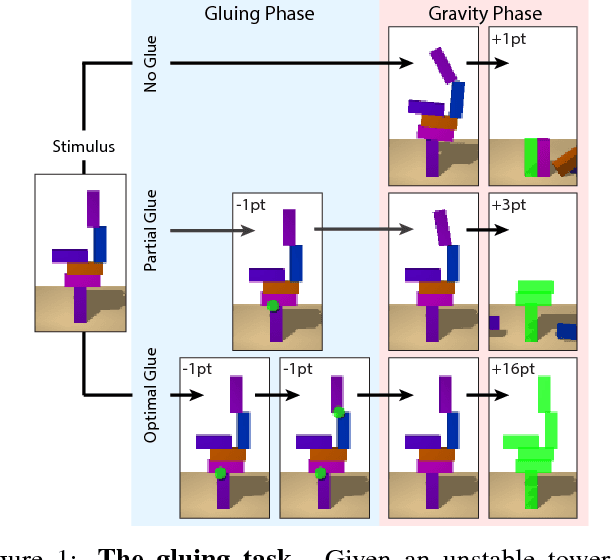
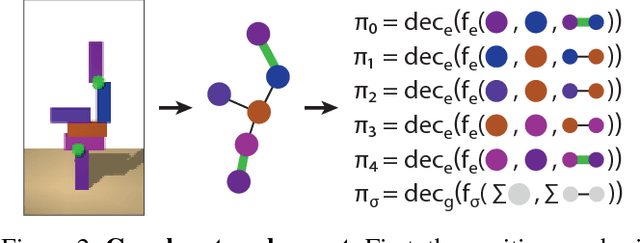
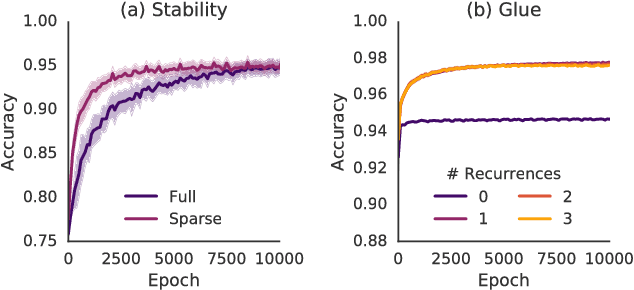
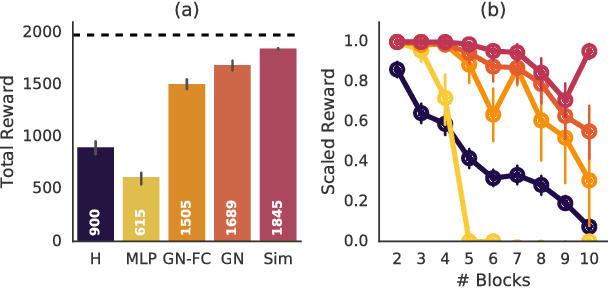
Abstract:While current deep learning systems excel at tasks such as object classification, language processing, and gameplay, few can construct or modify a complex system such as a tower of blocks. We hypothesize that what these systems lack is a "relational inductive bias": a capacity for reasoning about inter-object relations and making choices over a structured description of a scene. To test this hypothesis, we focus on a task that involves gluing pairs of blocks together to stabilize a tower, and quantify how well humans perform. We then introduce a deep reinforcement learning agent which uses object- and relation-centric scene and policy representations and apply it to the task. Our results show that these structured representations allow the agent to outperform both humans and more naive approaches, suggesting that relational inductive bias is an important component in solving structured reasoning problems and for building more intelligent, flexible machines.
 Add to Chrome
Add to Chrome Add to Firefox
Add to Firefox Add to Edge
Add to Edge